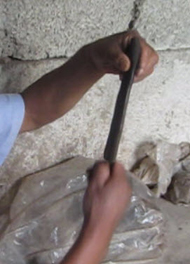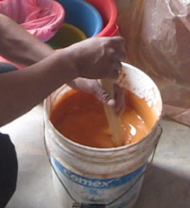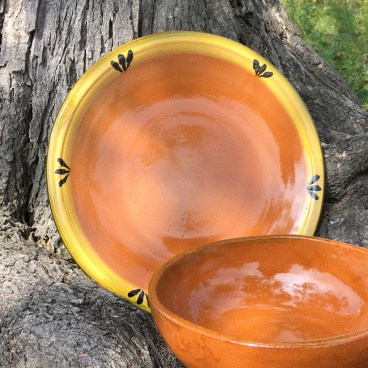Mexican Clay Plate - 10 inch Trefoil Design
About the piece
Care and Use
Curing
How they are Made
Our hand-made, 10 inch Mexican Clay Plate, is an excellent way of adding a rustic touch to an elegant table. Whether used to serve a meal on its own, or as a base for our Soup Bowl (sold separately), it make for a great presentation.
The plate is made of extra think clay which makes it very durable. It has a natural clay terracotta color, highlighted by a translucent yellow and green rim and accented with black trefoil leaves.
| Item Number: | MEX-3001-10 |
| Dimensions (inches): | |
| Length: | 10.5 |
| Width: | 10.5 |
| Height: | 1.5 |
| Diameter: | 10.5 |
| How we measure |  |
About the Mexican Clay Cazuela
The Cazuela is well-known throughout Mexico and can be found in just about any Mexican kitchen. They are an essential tool for Mexican cuisine and lend an authentic flavor and ambience to any Mexican table. They are widely used to prepare and serve many traditional dishes such as stews and casserole-style dishes, and great for slow cooking moles, which when simmered over an open flame acquire a special smoky taste.
Our Cazuelas come from the semi-desert region in the Mexican state of Hidalgo, where they are laboriously made by hand by our experienced artisans using 100% lead free glazes. They are certified lead free and completely safe for food use.
The pieces can be used in the oven, microwave, stovetop, or even direct flames, and can go directly to the table for an authentic presentation. The pieces can be used on a gas or electric range, however, a heat diffuser is recommended on electric ranges. And unlike other Cazuelas, ours are glazed inside and out making cleanup a breeze. The heat diffuser (which can be used with gas stove as well) has the added benefit of distributing the heat slowly to prevent foods from burning. Clay cookware can also be used on induction cooktops with the use of an induction cookware interface disk.
A Mexican Clay Plate is not only beautiful, but also quite sturdy and will last many years with proper use and care. Not only can the plate be used to serve, but since they are made out of clay, you can actually cook with them as demonstrated by the video to the right making Queso Fundido on one of our clay plates.
The plates can be used in the oven, microwave, stovetop, or even direct flames, and can go directly to the table for an authentic presentation. The plates can be used on a gas or electric range, however, a heat diffuser is recommended on electric ranges. The heat diffuser (which can be used with gas stove as well) has the added benefit of distributing the heat slowly to prevent foods from burning. Clay cookware can also be used on induction cooktops with the use of an induction cookware interface disk.
As with any clay or glass cookware, the plates must not be submitted to drastic changes in temperature. The pieces should be allowed to slowly adjust to heat, letting the pieces slowly heat up until they are hot. Likewise, always allow the pieces to cool to room temperature before washing or storing them, and never set a hot pot on a cold surface such as granite or tile.
Our Cazuelas, unlike others, are glazed inside and out making cleanup a breeze. The pieces should never be placed in a dishwasher, but should only be washed by handed with warm soapy water. If heavily soiled, fill the pieces with warm soapy water and allow it to soak briefly, then scrubbing lightly with a sponge or soft cloth. Never use metal or abrasive cleaners, and always try to avoid strongly scented soaps which can flavor the clay.
Make sure to thoroughly dry the clay pieces before storing them to make sure that they do not grow mold. If they do, wash them well and soak them in a bleach solution of one part bleach and 20 parts water. This is an effective way to kill mold.
Our Cazuelas are made from very fine clay and may be used after slowly bringing some water to the boil and need no further curing. The Cazuelas do benefit however from seasoning it prior to its first use, which can be simply accomplished by adding a couple of peeled garlic cloves to the boiling water use to cure the Cazuela.
The seasoning on the surface will increase with use; adding its signature flavor to the items cooked in it, and over time actually become naturally nonstick and requires low maintenance.
Deep inside Mexico, in the semi-desert region in the Mexican state of Hidalgo, our cazuelas are made by hand by artisans whose craft has been handed down for several generations. Unlike their ancestors’ methods, today, the process has been changed for the better by glazing the cazuelas with lead-free glazes. On the right, you can see the video on the entire process.
The process begins by the unearthing of the clay from local quarries.The chunks of clay are then transported o the artisan’s  compounds and spread out to dry thoroughly. Once dry, the chunks are ground with the help of an electric grinder, a modern day addition, until they are ground into a fine powder. The powder is then sieved to insure a uniform size, as well as eliminating any possible rocks or pebbles.
compounds and spread out to dry thoroughly. Once dry, the chunks are ground with the help of an electric grinder, a modern day addition, until they are ground into a fine powder. The powder is then sieved to insure a uniform size, as well as eliminating any possible rocks or pebbles.
The finely ground clay is combined with a little water and mixed by hand.  The artisan continues adding water and kneading the mixture, much like a bread maker kneads bread. For the normally large batches this is done on the floor of their workshop.
The artisan continues adding water and kneading the mixture, much like a bread maker kneads bread. For the normally large batches this is done on the floor of their workshop.
To make the clay cazuelas, the artisan takes a piece of clay sufficiently large for the intended piece, and pounds it to the thickness required by the piece with a tool much like a meat pounder made from lava rock, the same material as a Molcajete.
 The flattened clay is then molded over molds of the desired shape and size to ensure accurate reproduction of sizes. The piece is then rubbed by hand with water, and further rubbed with a wet lava stone to seal the pores of the clay.
The flattened clay is then molded over molds of the desired shape and size to ensure accurate reproduction of sizes. The piece is then rubbed by hand with water, and further rubbed with a wet lava stone to seal the pores of the clay.
The clay is then turned over and out of the mold, and let to air dry. Once the clay begins to harden, the interior is smoothed with a wet sponge and rubbed with a small wet lava stone to seal the pores on the interior of the piece. The rubbing inside and out of the pieces is a time consuming and laborious task, but results in excellent quality cazuelas, unlike some others rustically made which are available.
The next step of the process is the putting of the handles. To do so, the artisan begins by rolling a piece of  clay forming a rod shaped piece. The rod is then slowly flattened on the work bench using the palms. Dipping the rod in water to make it slippery, the artisan then holds the flattened rod with one hand he uses his other hand to run his thumb downward along the flattened rod to shape the handle the desired contour and making ridges. He then snips off a length to trim the handle to the required length.
clay forming a rod shaped piece. The rod is then slowly flattened on the work bench using the palms. Dipping the rod in water to make it slippery, the artisan then holds the flattened rod with one hand he uses his other hand to run his thumb downward along the flattened rod to shape the handle the desired contour and making ridges. He then snips off a length to trim the handle to the required length.
 Once the handle is shaped, he attaches the handle to the piece smoothing the joint between the two pieces of clay making the joint invisible.
Once the handle is shaped, he attaches the handle to the piece smoothing the joint between the two pieces of clay making the joint invisible.
 Once fully dry, the now dry and brittle pieces are sanded inside and out with porous lava rocks to ensure a smooth finish, and leaving them ready for the first firing. The first firing is done in a dome shaped wood burning over for over three hours. The pieces are stacked one on top of another in the upper chamber of the oven, while a hard wood fire is lit in the bottom chamber eventually reaching temperatures of over 1,000 degrees Fahrenheit.
Once fully dry, the now dry and brittle pieces are sanded inside and out with porous lava rocks to ensure a smooth finish, and leaving them ready for the first firing. The first firing is done in a dome shaped wood burning over for over three hours. The pieces are stacked one on top of another in the upper chamber of the oven, while a hard wood fire is lit in the bottom chamber eventually reaching temperatures of over 1,000 degrees Fahrenheit.
After the firing, the cooled pieces are then glazed. Our products are glazed with 100% lead free glazes which are arduously mixed slowly by hand so as to not introduce bubbles. To glaze the pieces, the artisan carefully dips the entire pieces in the glaze, letting the excess drip away. For larger pieces, the glaze is splashed on and let drip off. The glaze immediately begins to dry and become opaque. Once semi-dry, the bottom is scraped with a hard plastic tool to remove the glaze from the bottom which can cause the piece to stick to the kiln in the second firing. The bottom is then cleaned with a wet sponge.
Once the glaze is fully dry, the piece is then ready for the second firing. The second firing is done in a modern gas kiln to better control the temperature and conditions. If during the second firing, the temperature is too low, the glaze will not mature or become transparent, and if too high, it will become too melted and actually run off the piece.

The pieces are then fired at between 950 to 1,000 degrees Fahrenheit and result in the beautiful Mexcian Clay Cazuelas we offer. After experiencing the entire process, which all told can take anywhere from 15 to 20 days from extracting the clay to the finished product, we have gained an appreciation for the artisans craft and a greater respect for their work.









